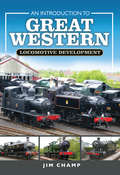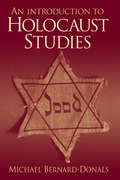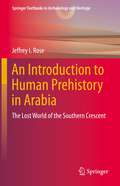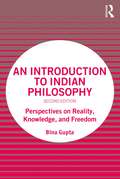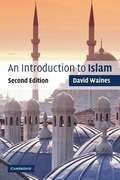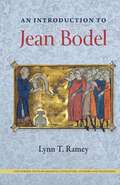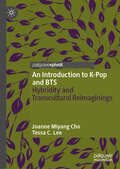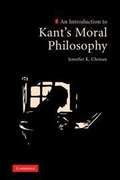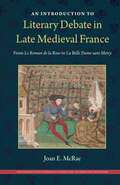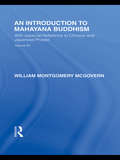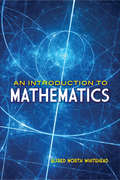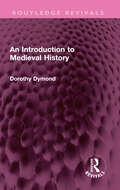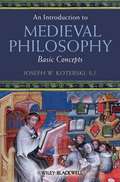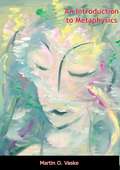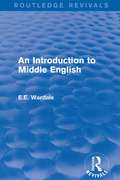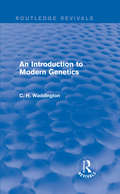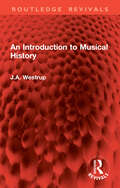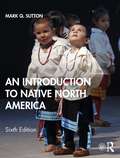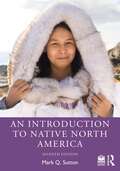- Table View
- List View
An Introduction to German Pietism: Protestant Renewal at the Dawn of Modern Europe (Young Center Books in Anabaptist and Pietist Studies)
by Douglas H. ShantzAn up-to-date portrait of a defining moment in the Christian story—its beginnings, worldview, and cultural significance.Winner of the Dale W. Brown Book Award of the Young Center for Anabaptists and Pietist Studies at Elizabethtown CollegeAn Introduction to German Pietism provides a scholarly investigation of a movement that changed the history of Protestantism. The Pietists can be credited with inspiring both Evangelicalism and modern individualism.Taking into account new discoveries in the field, Douglas H. Shantz focuses on features of Pietism that made it religiously and culturally significant. He discusses the social and religious roots of Pietism in earlier German Radicalism and situates Pietist beginnings in three cities: Frankfurt, Leipzig, and Halle. Shantz also examines the cultural worlds of the Pietists, including Pietism and gender, Pietists as readers and translators of the Bible, and Pietists as missionaries to the far reaches of the world. He not only considers Pietism's role in shaping modern western religion and culture but also reflects on the relevance of the Pietist religious paradigm of today.The first survey of German Pietism in English in forty years, An Introduction to German Pietism provides a narrative interpretation of the movement as a whole. The book's accessible tone and concise portrayal of an extensive and complex subject make it ideal for courses on early modern Christianity and German history. The book includes appendices with translations of German primary sources and discussion questions.
An Introduction to Great Western Locomotive Development
by Jim ChampThe first thought, when contemplating a new study of the Great Western Railway locomotive fleet, must surely be to ask what can there be left to say? But there is no single source which gives a general introduction to the Great Western locomotive fleet. There are monographs on individual classes, an excellent multi-volume detail study from the RCTS, and superb collections of photographs, but nothing that brings it all together. This work is intended to provide that general introduction.The volume begins with a series of short essays covering general trends in design development, whilst the main body of the volume covers individual classes. For each class there is a small table containing some principal dimensions and paragraphs of text, covering an introduction, renumbering, key changes in the development of the class and information on withdrawal.The volume concludes with appendices covering the development and types of standard boilers, the various numbering schemes used by the GWR, the arcane subject of locomotive diagrams and lot numbers, and a short reference on the many lines the GWR engulfed.The majority of illustrations are new profile drawings to a consistent format. Described as sketches, they are drawn to a consistent scale, but do not claim to be scale drawings. Much minor equipment has been omitted and the author has certainly not dared to include rivets! Although most are based around GWR weight diagrams, they are not simple traces of the original drawings. Detail has been added from other sources, components copied from different drawings and details have been checked against historical and modern photographs. One must also bear in mind that steam locomotives were not mass produced. Minor fittings frequently varied in position and changes were made over the locomotives' lifetimes. Nevertheless, this collection of drawings provides a uniquely consistent view of the GWR locomotive fleet.
An Introduction to Holocaust Studies
by Michael Bernard-DonalsThis single volume traces three approaches to the study of the Holocaust - through notions of history, theories of memory, and a focus on art and representation. It introduces students to the different ways we have come to understand the Holocaust, gives them an opportunity to ask questions about those conclusions, and examines how this event can be understood once all the survivors are gone. In addition, the book looks at the different disciplines - history, sociology, religious studies, and literary interpretation, among others - through which studies of the Holocaust take place.
An Introduction to Human Prehistory in Arabia: The Lost World of the Southern Crescent (Springer Textbooks in Archaeology and Heritage)
by Jeffrey I. RoseThis textbook explores the mystery of human origins in the Arabian Peninsula, the lost Southern Crescent where humanity took its first steps toward civilization. Under Arabia’s surface of sand and stone lies a primordial realm of rolling grasslands, freshwater lakes, and river floodplains. This book aims to restore a critical missing chapter in the prehistory of our species that played out in this forgotten place of plenty. The author has carried out more than twenty years of fieldwork in Yemen and Oman, weaving his research together into an unorthodox tapestry of archaeology, environmental science, genetics, and Middle Eastern mythology. This volume peers beneath Arabia’s abandoned deserts, revealing a land that once served as a bridge between prehistoric worlds. This textbook is suitable for undergraduate and graduate students as well as all readers who are interested in learning about Arabian prehistory.
An Introduction to Iconography: Symbols, Allusions and Meaning in the Visual Arts (Documenting The Image Ser. #Vol. 1)
by Roelof van StratenAvailable for the first time in English, An Introduction to Iconography explains the ways that artists use references and allusions to create meaning. The book presents the historical, theoretical, and practical aspects of iconography and ICONCLASS, the comprehensive iconographical indexing system developed by Henri van de Waal. It gives particular emphasis to the history of iconography, personification, allegory, and symbols, and the literary sources that inform iconographic readings, and includes annotated bibliographies of books and journal articles from around the world that are associated with iconographic research.The author of numerous articles and a four-volume reference work on Italian prints, Roelof van Straten is currently working on an iconographic index covering the prints of Goltzius and his school.
An Introduction to Indian Philosophy: Perspectives on Reality, Knowledge, and Freedom
by Bina GuptaAn Introduction to Indian Philosophy offers a profound yet accessible survey of the development of India’s philosophical tradition. Beginning with the formation of Brahmanical, Jaina, Materialist, and Buddhist traditions, Bina Gupta guides the reader through the classical schools of Indian thought, culminating in a look at how these traditions inform Indian philosophy and society in modern times. Offering translations from source texts and clear explanations of philosophical terms, this text provides a rigorous overview of Indian philosophical contributions to epistemology, metaphysics, philosophy of language, and ethics. This is a must-read for anyone seeking a reliable and illuminating introduction to Indian philosophy.
An Introduction to Indian Philosophy: Perspectives on Reality, Knowledge, and Freedom
by Bina GuptaAn Introduction to Indian Philosophy offers a profound yet accessible survey of the development of India’s philosophical tradition. Beginning with the formation of Brāhmaṇical, Jaina, Materialist, and Buddhist traditions, Bina Gupta guides the reader through the classical schools of Indian thought, culminating in a look at how these traditions inform Indian philosophy and society in modern times. Offering translations from source texts and clear explanations of philosophical terms, this text provides a rigorous overview of Indian philosophical contributions to epistemology, metaphysics, philosophy of language, and ethics. This is a must-read for anyone seeking a reliable and illuminating introduction to Indian philosophy. Key Updates in the Second Edition Reorganized into seven parts and fifteen chapters, making it easier for instructors to assign chapters for a semester-long course. Continues to introduce systems historically, but focuses on new key questions and issues within each system. Details new arguments, counter-arguments, objections, and their reformulations in the nine schools of Indian philosophy. Offers expanded discussion of how various schools of Indian philosophy are engaged with each other. Highlights key concepts and adds new grey boxes to explain selected key concepts. Includes a new section that problematizes the Western notion of "philosophy." New Suggested Readings sections are placed at the end of each chapter, which include recommended translations, a bibliography of important works, and pertinent recent scholarship for each school. Adds a new part (Part III) that explains the difficulties involved in translating from Sanskrit into English, discusses fundamental concepts and conceptual distinctions often used to present Indian philosophy to Western students, and reviews important features and maxims that most darśanas follow. Provides new examples of applications to illustrate more obscure concepts and principles.
An Introduction to Islam (Second Edition)
by David WainesThis wide-ranging account of the history and theology of one of the world's most dynamic religions tells the story of Islamic beliefs and practices as they developed from the earliest times down to the present day. For this revised and updated Second Edition, David Waines has added a long section tackling head-on the issues arising from Islam's place in the changing world order at the turn of the new millennium. The wars in Bosnia, Afghanistan and Israel, and the terrorist attacks on New York and Washington, have raised global awareness of Islam at a superficial level - but little has been written which considers Islamic political and military extremism in relation to mainstream Muslim history and theology. Coming at the end of a book which has explored the ideas and traditions of Islam in depth, this new section offers thought-provoking reflections on the place of religion in the current conflicts.
An Introduction to Jean Bodel (New Perspectives on Medieval Literature: Authors and Traditions)
by Lynn T. RameyBringing the work of a highly influential medieval French writer to English-speaking audiences for the first time This book explores the life and works of Jean Bodel, an influential author who lived in twelfth-century Arras, France. A versatile poet, playwright, and epic writer who established new genres such as fabliaux and the mystery play, Bodel remains relatively unknown to Anglophone audiences. Lynn Ramey offers translations and summaries of works never published before in English while delving into Bodel’s historical and cultural context. After a brief introduction to the poet, Ramey highlights the stimulating and cosmopolitan environment of Arras, considering the influence of the Crusades and social movements in shaping Bodel’s works. Next, Ramey provides an extensive survey of all of Bodel’s known writing across his prolific career by genre, from his most well-known work, The Play of Saint Nicholas (Le Jeu de saint Nicolas), to his final piece, Farewell (Les Congés), which offers important insight into his diagnosis of leprosy toward the end of his life. Ramey translates several pieces including pastourelles, fabliaux, and selections from the Song of the Saxons (Chanson des Saisnes). The book also includes information on Bodel’s sources, a chronology, and a glossary. With much of the existing scholarship on Bodel only available in French, this book bridges a gap in knowledge of the poet and serves as a useful resource for both students and specialists. An Introduction to Jean Bodel allows a broader audience to engage with the writer’s wide-ranging work and contributions to literary history.A volume in the series New Perspectives on Medieval Literature: Authors and Traditions, edited by R. Barton Palmer and Tison Pugh
An Introduction to K-Pop and BTS: Hybridity and Transcultural Reimaginings
by Joanne Miyang Cho Tessa C. LeeThis Palgrave Pivot examines a key area of the Korean Wave or Hallyu, which stands for the global popularity of South Korean popular culture that started in the 1990s. While K-dramas (Korean dramas) have found many viewers throughout Asian countries and some Western countries in recent years, K-pop (Korean popular music) has had broader appeal not only to Asian audiences, but also American (North and South), European, and Middle-Eastern audiences. This book&’s unique contribution is to provide a concise and succinct analysis of K-pop from transcultural perspectives through its most famous example, BTS. The first chapter contextualizes K-pop within the Korean Wave movement. The second and third chapters provide a history of K-Pop, spanning from Seo Taiji and Boys in the early 1990s to the present (including BTS and Blackpink), and presents K-pop as a glocalized phenomenon. The fourth, fifth, and sixth chapters critically examine the most prominent band in the K-pop world, BTS, and the unique connections to their transnational fandom called ARMY.
An Introduction to Kant'S Moral Philosophy
by Jennifer K. UlemanImmanuel Kant's moral philosophy is one of the most distinctive achievements of the European Enlightenment. At its heart lies what Kant called the 'strange thing': the free, rational, human will. This introduction explores the basis of Kant's anti-naturalist, secular, humanist vision of the human good. Moving from a sketch of the Kantian will, with all its component parts and attributes, to Kant's canonical arguments for his categorical imperative, this introduction shows why Kant thought his moral law the best summary expression of both his own philosophical work on morality and his readers' deepest shared convictions about the good. Kant's central tenets, key arguments, and core values are presented in an accessible and engaging way, making this book ideal for anyone eager to explore the fundamentals of Kant's moral philosophy.
An Introduction to Latin American Economics: Understanding Theory Through History
by Scott McKinneyThis textbook serves as an introduction to the major economic topics and events in Latin America’s history, from the settling of the region by indigenous Americans and then Europeans, Africans and Asians, to the economic consequences of COVID-19. Each chapter concentrates on a particular period—for example, pre-Columbian America, the 1980s debt crisis, the 21st Century decline in income inequality—and introduces the concepts needed to understand the events of that period. These concepts include theories such as Dutch Disease and Dependency Theory, policies such as import-substituting industrialization and neoliberalism, and analytical tools such as the circular flow of income and the foreign exchange market. Descriptive data are used to illustrate these concepts: for example, Latin America’s current account balance during the 1970s and 1980s shows the impact of the debt crisis, while the relationship between money supply growth and inflation in Argentina during the 1980s and 1990s shows the impact of expansionary monetary policy and convertibility.With its focus on Latin American economic history and on the key concepts for understanding that history, this book can serve as the core textbook for an introductory course on Latin American Economics, or as a complementary text for an introductory course in Latin American Studies or a social science course on Latin America.
An Introduction to Literary Debate in Late Medieval France: From Le Roman de la Rose to La Belle Dame sans Mercy (New Perspectives on Medieval Literature: Authors and Traditions)
by Joan E. McRaeHow medieval poems sparked discussions on women’s agency, love, marriage, and honor that prefigured modern feminism This volume immerses readers in a debate tradition that flourished in France during the late Middle Ages, focusing on two works that were both popular and controversial in their time: Le Roman de la Rose by thirteenth-century poets Guillaume de Lorris and Jean de Meun and La Belle Dame sans Mercy by fifteenth-century royal secretary and poet Alain Chartier. This is the first comparative volume on these important works and the discussions they sparked. Engaging with questions of women’s agency, love, marriage, and honor, these two poems prompted responses that circulated via treatises, letters, and sermons among officials, clerics, and poets. Joan McRae provides commentary on the two texts, a timeline and summary of the resulting debates, and biographical sketches of the leading intellectuals who matched wits over different ways of reading the texts, including pioneering writer Christine de Pizan. McRae shows that these works and the debates, read together, consider a range of social issues that raise questions of gender, the place of power and hierarchy in societal relationships, and the responsibility of writers for the effect of their works on readers. An Introduction to Literary Debate in Late Medieval France is a helpful overview of these weighty arguments for both students and scholars. McRae provides a compact, comprehensive, and up-to-date study, spotlighting influential literary expressions that evolved into the “querelle des femmes,” the “woman question,” which in turn paved the way for modern feminism. A volume in the series New Perspectives on Medieval Literature: Authors and Traditions, edited by R. Barton Palmer and Tison Pugh
An Introduction to Mahāyāna Buddhism: With especial Reference to Chinese and Japanese Phases (Routledge Library Editions: Japan)
by William M McGovernWilliam Montgomery McGovern’s Introduction to Mahayana Buddhism was one of the first books on Mahayana Buddhism written for a Western audience. It predates influential English language overviews of Buddhism by D. T. Suzuki, A. Watts, and W. Rahula. The author was born in New York City in 1897 and spent his latter teenage years (1914-1917) training at the Nishi Hongwanji Mahayana Buddhist monastery in Kyoto, Japan. He founded the Mahayana Association at age eighteen and edited and published the journal "Mahayanist" while completing his studies at the monastery. Introduction to Mahayana Buddhism was written as part of a thesis which secured him his Buddhist degree and an honorary ordination as a Buddhist priest. Intended as a simplified and introductory text for a lay audience, the book reflects the unique perspective of a Westerner trained in Japan at a time when Mahayana Buddhism was little known in the West. Referencing Buddhist literature, it gives a short history of Buddhism and the divergence of schools of Buddhist philosophy, introduces the four noble truths, the philosophy of Karma, the nature of Buddhahood, reincarnation and the road to nirvana, Buddhist cosmology, and psychological and philosophical elements of Buddhist teachings. Although the divisions of non Mahayana Buddhist sects and philosophy described may be considered dated, Introduction to Mahayana Buddhism remains significant for its historical value in presenting Eastern religious and philosophical thought to Westerners at a pivotal time in history.
An Introduction to Mathematics (Dover Books on Mathematics)
by Alfred North Whitehead"The object of the following chapters is not to teach mathematics, but to enable students from the very beginning of their course to know what the science is about, and why it is necessarily the foundation of exact thought as applied to natural phenomena." Thus begins this volume by the prominent English philosopher and mathematician Alfred North Whitehead, a concise statement on the nature and meaning of mathematics for the general student. Expertly written and abounding in insights, the book presents a lively exposition of mathematical concepts, the history of their development, and their applications to the physical world. Whitehead explains in broad terms what mathematics is about, what it does, and how mathematicians do it.Generations of readers who have stayed with the philosopher from the beginning to the end have found themselves amply rewarded for taking this journey.
An Introduction to Medieval History (Routledge Revivals)
by Dorothy DymondFirst Published in 1929 An Introduction to Medieval History presents a comprehensive overview of the social, political, and religious movements that inspired medieval civilization and still influence the civilization of our own day. It brings crucial themes like the heritage of Rome; church and the Empire; the peasant and his Lord; nations and kings; empire and papacy; the eastern empire and the Crusades; transition to modern times; decline of empire and papacy; decline of feudalism and development of trade; and towns and the Renaissance. This introductory book is useful for history students in secondary schools and training colleges and general readers interested to know about the medieval times.
An Introduction to Medieval Philosophy: Basic Concepts
by Joseph W. KoterskiBy exploring the philosophical character of some of the greatest medieval thinkers, An Introduction to Medieval Philosophy provides a rich overview of philosophy in the world of Latin Christianity. Explores the deeply philosophical character of such medieval thinkers as Augustine, Boethius, Eriugena, Anselm, Aquinas, Bonaventure, Scotus, and Ockham Reviews the central features of the epistemological and metaphysical problem of universals Shows how medieval authors adapted philosophical ideas from antiquity to apply to their religious commitments Takes a broad philosophical approach of the medieval era by,taking account of classical metaphysics, general culture, and religious themes
An Introduction to Metaphysics
by Martin O. VaskeA clear, solid and succinct textbook in metaphysics, An Introduction to Metaphysics, which was first published in 1963, begins with a chapter on the existence of all things (including ourselves) and then proceeds to discuss the subjects of changing existents; participating, multiple existents; efficient causes; final and exemplary causes; the Primary Cause; the transcendental properties; categories of limited being; and the analogy of being.
An Introduction to Middle English
by E.E. WardaleFirst published in 1937, this book supplies a history of the living growth of the English language from Old English to the medieval period. It offers an in-depth study of the growth of vocabulary through literature and social interaction, bringing out the fact that it is chiefly words that foreign influence has affected — leaving sentence structure almost unaltered. Isolative and combinative changes in phonology, the accidence of nouns and plurals, pronouns and adverbs, and verbs are also examined in detail, along with a general overview of the features Middle English and a brief outline of each dialect’s most striking characteristics.
An Introduction to Modern Genetics (Routledge Revivals: Selected Works of C. H. Waddington)
by C. H. WaddingtonFirst published in 1939 (second impression in 1950), this book provides an account of the changes in, and main principles of, genetics at that time. These are illustrated by references to the most authoritative and then recent investigations. Special attention is paid to the way in which genetics overlaps with other fields of inquiry, since it is often in these border-line subjects that the most important advances are to be expected. The book is particularly arranged to suit the convenience of students whose previous knowledge of genetics is small, and contains annotated bibliographies of suggestions for further reading.
An Introduction to Music and Art in the Western World (10th edition)
by Milo Wold Edmund Cykler Gary Martin James MillerAn undergraduate introduction to the music, painting, sculpture, and architecture of the Western world, featuring chapter objectives and summaries, pronunciation guides, and chronologies. Covers various periods from the ancient Greeks through the arts today, and includes material on the arts and society and the organization of the elements of art and music. This 10th edition contains increased recognition of women and minority artists, and boxes on selected individual works. Annotation c. by Book News, Inc., Portland, Or.
An Introduction to Musical History (Routledge Revivals)
by J.A. WestrupFirst published in 1955, An Introduction to Musical History is not just another short history of music, but a discussion of its sources and background. It explains how we derive our knowledge of the music of the past, and how music has been affected by its social and political background. Such topics as the influence of language and racial characteristics find their place here, as well as the contributions made by literature and painting. Some of the problems presented by musical history are examined, and an indication is given of the best method of studying it. This book will be an interesting read for students and researchers of music.
An Introduction to Native North America
by Mark Q. SuttonAn Introduction to Native North America provides a basic introduction to the Native Peoples of North America, covering what are now the United States, northern Mexico, and Canada. It covers the history of research, basic prehistory, the European invasion and the impact of Europeans on Native cultures. A final chapter covers contemporary Native Americans, including issues of religion, health, and politics. In this updated and revised new edition, Mark Q. Sutton has expanded and improved the existing text as well as adding a new case study, updated the text with new research, and included new perspectives, particularly those of Native peoples. Featuring case studies of several tribes, as well as over 60 maps and images, An Introduction to Native North America is an indispensable tool to those studying the history of North America and Native Peoples of North America. .
An Introduction to Native North America
by Mark Q. SuttonAn Introduction to Native North America provides a basic introduction to the Native peoples of North America, covering what are now the United States, northern Mexico, and Canada. In this updated and revised new edition, Mark Q. Sutton has expanded and improved the existing text, adding to the case studies, updating the text with the latest research, increasing the number of images, providing more coverage of the Arctic regions, and including new perspectives, particularly those of Native peoples. The book addresses the history of research, the European invasion, and the impact of Europeans on Native societies. A final chapter introduces contemporary Native Americans, discussing issues that affect them, including religion, health, and politics. The book retains a wealth of pedological features to aid and reinforce learning. Featuring case studies of many Native American groups, as well as some eighty-four maps and images, An Introduction to Native North America is an indispensable tool to those studying the history of North America and its Native peoples.
An Introduction to Native North America
by Mark Q. SuttonAn Introduction to Native North America provides a basic introduction to the Native peoples of North America, covering what are now the United States, northern Mexico, and Canada.In this updated and revised new edition, Mark Q. Sutton has expanded and improved the existing text, adding to the case studies, updating the text with the latest research, increasing the number of images, providing more coverage of the Arctic regions, and including new perspectives, particularly those of Native peoples. This book addresses the history of research, the European invasion, and the impact of Europeans on Native societies. A final chapter introduces contemporary Native Americans, discussing issues that affect them, including religion, health, and politics. The book retains a wealth of pedological features to aid and reinforce learning.Featuring case studies of many Native American groups, as well as some 87 maps and images, An Introduction to Native North America is an indispensable tool to those studying the history of North America and its Native peoples.

